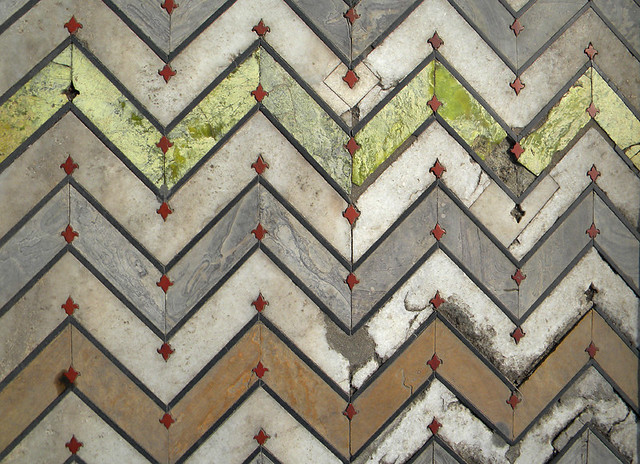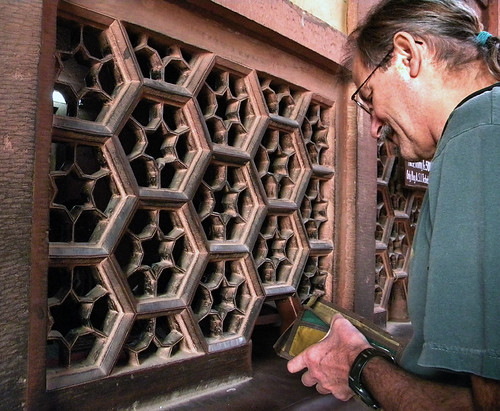The Mughal Empire in India was formed by invaders from Persia who brought with them their Muslim religion, as well as its strictures placed on images, in that they were usually not of people or animals, only design elements and calligraphy.
A design element is a line or shape, and if it repeats itself it turns into a pattern.
Our first exposure to Mughal architecture was in Delhi at the Red Fort. The red stone had curvilinear floral patterns.
 A repetition of arched marble cubbyholes forms a pattern at the Red Fort, added to which it’s three-dimensionality created a repeating pattern of the shadows as well.
A repetition of arched marble cubbyholes forms a pattern at the Red Fort, added to which it’s three-dimensionality created a repeating pattern of the shadows as well. Next up was the city of Agra, which was chock full of expensive architecture. When Shah Jahan (one of five prominent Mughal emperors) came into power, he began to build so many monuments (including the masterpiece of architecture, the Taj Mahal) that he bankrupted the empire. The surface decoration of the Taj Mahal is primarily floral, the marble walls carved and inlaid with semi-precious stones.
Next up was the city of Agra, which was chock full of expensive architecture. When Shah Jahan (one of five prominent Mughal emperors) came into power, he began to build so many monuments (including the masterpiece of architecture, the Taj Mahal) that he bankrupted the empire. The surface decoration of the Taj Mahal is primarily floral, the marble walls carved and inlaid with semi-precious stones.
 On either side of the white marble Taj was a mosque in carved red stone. This one had zigzag patterns on the exterior.
On either side of the white marble Taj was a mosque in carved red stone. This one had zigzag patterns on the exterior. In our stocking feet we had to tread carefully around the pigeon droppings, taking several photos of the dim hallways, again with a repetition of the niche shape in a subtle form on the walls, and in red and white on the floors.
In our stocking feet we had to tread carefully around the pigeon droppings, taking several photos of the dim hallways, again with a repetition of the niche shape in a subtle form on the walls, and in red and white on the floors. Geometric pattern of semi-precious stones at the Agra Fort, a 16th-century Mughal fortress, is another UNESCO World Heritage site in Agra, and in its own way just as beautiful as the Taj Mahal.
Geometric pattern of semi-precious stones at the Agra Fort, a 16th-century Mughal fortress, is another UNESCO World Heritage site in Agra, and in its own way just as beautiful as the Taj Mahal. The Agra Fort contained ‘classic’ sandstone cashier cage pierced with stars.
The Agra Fort contained ‘classic’ sandstone cashier cage pierced with stars. The buildings in Agra were often covered with surface decoration on every single surface. There was the Baby Taj; here a pigeon strutted on the patterned marble floors.
The buildings in Agra were often covered with surface decoration on every single surface. There was the Baby Taj; here a pigeon strutted on the patterned marble floors. The exterior and interior walls of Akbar’s tomb were intricately covered with designs that, according to Islamic tradition, only used geometric patterns, plant-life motifs and Arabic script. Akbar is probably the best known of the Mughal emperors, but he didn’t spend like Shah Jahan…
The exterior and interior walls of Akbar’s tomb were intricately covered with designs that, according to Islamic tradition, only used geometric patterns, plant-life motifs and Arabic script. Akbar is probably the best known of the Mughal emperors, but he didn’t spend like Shah Jahan… I think the Chini Tomb was older but its uniquely vaulted ceilings painted in way to accent the structure were a wonder to behold.
I think the Chini Tomb was older but its uniquely vaulted ceilings painted in way to accent the structure were a wonder to behold.  We took a local bus to Fatehpur Sikri, a mosque just outside of Agra. Although slightly less extravagant in its decoration it certainly had its moments.
We took a local bus to Fatehpur Sikri, a mosque just outside of Agra. Although slightly less extravagant in its decoration it certainly had its moments.

Further west, in Rajasthan, the patterns became less geometric and more extravagant, and often featured animals, birds and at times voluptuous dancers as the religious influence on decoration changed.


Great great patterns. Love the monkey, pigeon, and solitary figure accents too. Excellent.
Fantastic post Elizabeth – I would love to see these wonders someday. Your images are beautiful as always. Especially loved the doorway with the shadow figure.
The architecture of this empire has always fascinated me. The boy in prayer is so solitary – amazing when I consider the chaos that reined just outside the door…
Super nice and well taken pictures of these Indian patterns and structures!
Beautiful! And I loved the animal accents and the shadowy person sitting. These made the pictures even more brilliant!
Wow! Absolutely stunning! 🥰
Mughals were symbol creativity